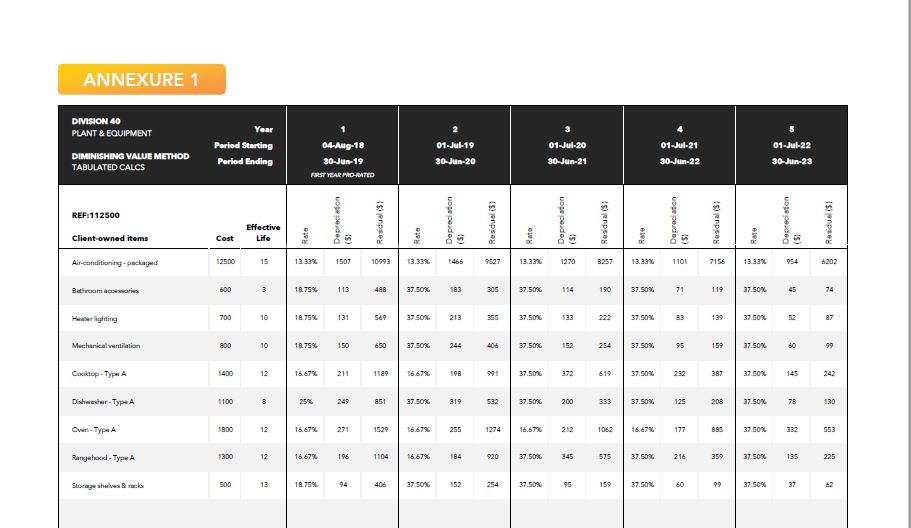An investment property depreciation schedule is among the most beneficial but underused tools available for property investors to maximise their tax returns.
All property investors want to pay less tax, yet 70% of investors don’t benefit from tax depreciation deductions because they don’t order an investment property depreciation schedule.
Are you a property investor that wants to take advantage of one of the most effective tools available to you, but don’t know where to start?
Don’t worry, we’ve got you covered.
We’ll guide you on all there is to know about ordering an investment property depreciation schedule including a brief introduction to property tax depreciation, the benefits of a tax depreciation schedule, what it includes as well as how you can get your hands on one.
What Is Rental Property Tax Depreciation?
Before equipping you with the benefits of an investment property depreciation schedule, you must understand property tax depreciation.
As a building gets older, its structure and the assets within the building are subject to general wear and tear. In other words, each year, the value decreases and thus, depreciates.

The Australian Tax Office (ATO) offers property investors the opportunity to claim the depreciating assets as a tax deduction, as long as the property is being used to generate an income.
There are two types of depreciation deductions available for property investors to claim:
- Capital Works Deductions
- Also known as Division 43 deductions, capital works refers to the depreciation (i.e. the general wear and tear) of the structural components of a property and any times fixed to the property including
- bricks and mortar;
- retaining walls;
- flooring; and among other things
- electrical wiring
- The structure of a residential building, if constructed after September 1987, generally has an effective life of 40 years. So, property investors can claim a capital works deduction at a percentage rate of 2.5% per annum over those 40 years
- Also known as Division 43 deductions, capital works refers to the depreciation (i.e. the general wear and tear) of the structural components of a property and any times fixed to the property including
- Division 40 – Plant and Equipment
- The term “plant and equipment” refers to the fixtures and fittings found within the building
- These are generally known as easily removable assets and include items such as:
- carpets;
- stovetops and ovens;
- blinds; and among other things
- air conditioning units
- Also referred to as division 40, plant and equipment assets depreciate over their effective life. According to the ATO, the effective life of a depreciating asset is how long it can be used to produce an income. For example, a carpet, subject to a fair amount of wear and tear, has an effective eight-year life
What Is an Investment Property Depreciation Schedule?
To claim your property’s depreciation deductions, you’ll have to identify the value of the property and all its fittings and fixtures.
To have your property evaluated, you’ll have to consult with a quantity surveyor. A quantity surveyor is a qualified construction expert who specialises in the assessment and observation of construction costs of a property.
Not only do quantity surveyors specialise in construction costs, but they are also recognised by the ATO as one of the few expert professions qualified to compile an investment property tax depreciation schedule for both residential and commercial property investors.
The investment property depreciation schedule is the report compiled by the quantity surveyor that details the value of both your Division 40 and Division 43 assets and how much it has depreciated and will depreciate in the future.
Example:
In March 2020, Travis bought his first investment property for $425,000 and decided to rent it out immediately.
After buying his investment property, he consulted with a quantity surveyor at Duo Tax to identify the value of his property and its assets. Based on his investment property depreciation schedule, his property’s construction commenced in April 2006 and was completed in January 2007.
The total cost of construction was estimated to be $305,000.
Travis’ investment property depreciation schedule outlines that he can claim a capital works deduction at a depreciation rate of 2.5% per annum, as the construction of his property commenced after 15 September 1987.
In his first year of owning the property, Travis was only able to rent out the property from 1 March 2020 to 30 June 2020, so he can claim a deduction for 122 days:
($305,000 x 2.5%) x (122 days of 366 days in 2020) = $2,541.67
So, Travis can claim a capital works deduction of $2,541.67 in his 2019-2020 tax return.
As the property was built in 2006, Travis’s investment property depreciation schedule will highlight the capital works deductions he can claim until 2046, provided that he still owns the property and it’s being used to produce income.
His investment property depreciation schedule also charts the depreciation of his plant and equipment assets. Below is a sample of the depreciation process in Travis’s investment property depreciation schedule drawn up by us at Duo Tax:

What Can You Expect To See in Your Investment Property Depreciation Schedule?
An investment property depreciation schedule typically includes the following sections:
- a glossary of terms to help you better understand each moving part of the investment property depreciation schedule;
- a 40-year breakdown of all Division 43 (capital works) items that can be depreciated;
- calculations using both the prime cost and diminishing value depreciation methods so you can make the best decision for your circumstances;
- the effective life and prescribed depreciation rate for all Division 40 (plant and equipment) assets; and
- a breakdown of the assets that qualify for an instant-asset write-off and those that can be added to low-value pools
Duo Tax has designed a tax depreciation calculator to help property investors estimate what they could potentially claim on tax depreciation before committing to purchasing a tax depreciation schedule.
You can also request a sample of an investment property depreciation schedule. Our depreciation reports are designed to be easy to read and provide clear instructions, so it’ll give you a good idea of how your report should look.
Why Should You Order an Investment Property Depreciation Schedule?
If you haven’t already guessed, there are numerous benefits of having a quantity surveyor draw up an investment property depreciation schedule.
But just in case you’re not 100% convinced yet, here is a list of some of the significant benefits:
- ordering a property investment depreciation schedule can be the difference between having a negatively geared property and enjoying an enhanced cash flow;
- having a positive cash flow makes buying your next property a more achievable option which will essentially help kickstart your property ladder climb;
- your investment property depreciation schedule is customised to cover all the benefits available to you under Australian law for new and older properties; and
- unlike other property deductions, an investment property depreciation schedule is a once-off cost, and you can potentially claim 40 years worth of depreciation deductions without spending money each financial year
You’ve Received Your Investment Property Depreciation Schedule – Now What?
A single investment property depreciation schedule provides 40 years of depreciation claims (or the maximum effective life), so you will only have to have your property inspected by a quantity surveyor once.
Also, did you know that quantity surveyor fees are a property tax deduction too?
Once you’ve received your investment property depreciation schedule, you’ll simply have to hand it over to your accountant, and they will submit the results in your tax return each financial year.
Key Takeaways
When you think about the fact that depreciation is the second-highest tax deduction on your property after interest on your loan, it’s unbelievable that 70% of investors aren’t taking advantage of the benefits of an investment property depreciation schedule.
Are you one of the 70% of investors who are missing out?
The Duo Tax team has helped thousands of property investors maximise their deductions and save thousands of dollars through the power of investment property depreciation schedules.
As avid investors ourselves, our objective is to help all investors get the most value out of their investments.
We offer free immediate and accurate over the phone estimates so that you can decide if ordering an investment property depreciation schedule is worth your while.
To order your investment property depreciation schedule today, all you need to do is follow these three simple steps:
- Get in touch with us today, and we will ask you a few simple questions to see if your property qualifies.
- Order a depreciation schedule over the phone or via our online form, and we will begin preparing your depreciation.
- Within 5-10 business days, your personalised depreciation report will be delivered to your and your accountant.

Ready to get started?
Talk to one of our friendly property experts to get a free quote or more Information.










